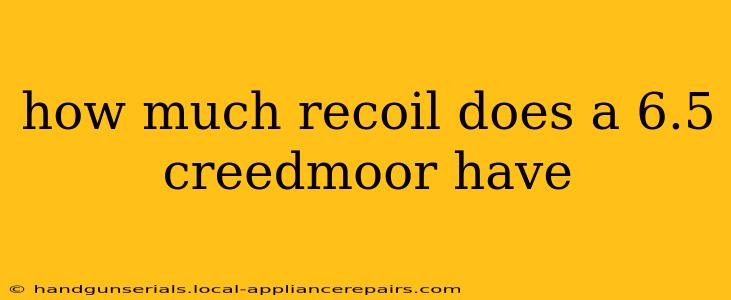The 6.5 Creedmoor has rapidly gained popularity among hunters and long-range shooters, largely due to its impressive accuracy and relatively mild recoil. But just how mild is it? This guide will delve into the specifics of 6.5 Creedmoor recoil, exploring the factors that influence it and helping you understand what to expect.
Understanding Recoil: More Than Just a "Kick"
Recoil isn't simply a subjective feeling of a "kick." It's a measurable force, governed by physics. Newton's Third Law of Motion—for every action, there's an equal and opposite reaction—perfectly describes firearm recoil. When a bullet is propelled forward, the rifle experiences an equal and opposite force backward.
Several factors influence the perceived recoil of a 6.5 Creedmoor:
-
Bullet Weight: Heavier bullets generally produce more recoil. A 140-grain bullet will have noticeably more recoil than a 120-grain bullet fired from the same rifle.
-
Powder Charge: The amount of propellant used significantly impacts recoil. Higher powder charges result in greater recoil.
-
Rifle Weight: A heavier rifle absorbs more of the recoil energy, making it feel less severe to the shooter. This is why heavier hunting rifles often feel less snappy than lighter sporting rifles.
-
Muzzle Brake: Muzzle brakes redirect some of the propellant gases, reducing felt recoil. However, they often produce significant muzzle blast and noise.
-
Stock Design: The design of the rifle stock, including its length of pull and the type of recoil pad, can affect how the recoil is distributed and felt by the shooter. A well-designed stock can significantly mitigate recoil.
Recoil Comparison: 6.5 Creedmoor vs. Other Calibers
The 6.5 Creedmoor often gets praised for its manageable recoil. Compared to calibers like the .308 Winchester or 7mm Remington Magnum, it generally exhibits less recoil. However, it's not completely recoil-free. Think of it as a middle ground—less than powerful magnums but more than some smaller calibers like the .223 Remington.
Here's a general comparison (remember, specifics vary based on factors mentioned above):
- Less Recoil Than: .30-06 Springfield, 7mm Remington Magnum, .300 Winchester Magnum
- Similar Recoil To: .308 Winchester (often slightly less)
- More Recoil Than: .223 Remington, .243 Winchester
Measuring Recoil: Free Recoil Energy
Free recoil energy is a quantitative measurement of recoil, typically expressed in foot-pounds (ft-lbs). While not a perfect indicator of felt recoil (which is subjective), it provides a useful comparison between different cartridges. The 6.5 Creedmoor generally has a free recoil energy between 10-15 ft-lbs, depending on the specifics of the cartridge. Again, heavier bullets and larger powder charges will increase this figure.
Is 6.5 Creedmoor Recoil Right for You?
The 6.5 Creedmoor's recoil is generally considered manageable for most shooters, even those with limited experience. However, individual tolerance varies. Factors like body size and strength influence how recoil is perceived. If you're unsure, renting or borrowing a 6.5 Creedmoor rifle before purchasing is a great way to assess your comfort level.
Conclusion: A Balanced Choice
The 6.5 Creedmoor strikes a commendable balance between performance and recoil. Its relatively mild recoil makes it accessible to a wide range of shooters, contributing to its considerable popularity. While not completely recoil-free, the manageable recoil, combined with its accuracy and effectiveness, makes it a top choice for many. Remember always to practice safe firearm handling and prioritize comfort and safety when choosing a firearm caliber.

